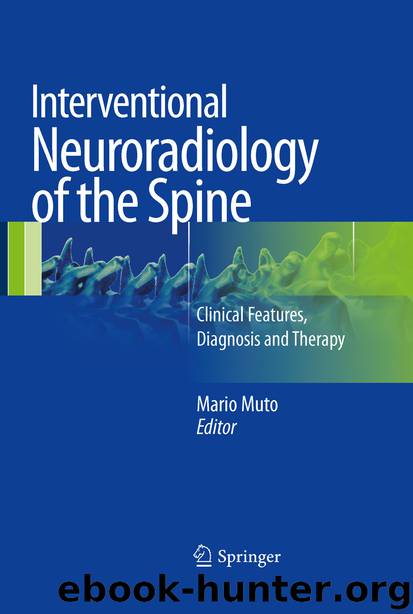Interventional Neuroradiology of the Spine by Mario Muto

Author:Mario Muto
Language: eng
Format: epub
Publisher: Springer Milan, Milano
10.2.5.2 Side Effects and Safety Profile of Denosumab
In general, denosumab is well tolerated with total adverse events and serious adverse events similar to those seen with placebo. The benefit of treatment with denosumab is likely to outweigh the risks in women with post-menopausal osteoporosis at high risk for fracture. Denosumab was approved for this indication at 60 mg by subcutaneous injection every 6 months. Safety has been evaluated in all of the denosumab clinical trials and their extensions.
In a report of a phase-I study of denosumab in healthy post-menopausal women, there were no related serious adverse events and no discontinuations from the study due to adverse events. A mild transient hypocalcemia and corresponding increases in serum intact PTH levels has been observed. Infectious adverse events were similar in denosumab (38%) and placebo (33%) groups. Two subjects treated with denosumab showed mild injection-site reactions. There were no changes in the counts for white blood cells, T-cells, B-cells, or natural killer cells, immunoglobulins, or coagulation parameters in association with denosumab treatment.
The four-year data for a phase-II study of denosumab in post-menopausal women with low BMD reported a similar prevalence of all adverse events and all serious adverse events in the placebo, denosumab, and alendronate groups. The prevalence of malignant neoplasms was similar in all treatment groups. The overall prevalence of infections was similar in all treatment groups, but infections requiring hospitalization occurred in 3.2% of denosumab-treated patients and none of those who received placebo or alendronate. All infections were typical community-acquired infections that responded appropriately to standard antibiotic therapy. No patient developed neutralizing antibodies to denosumab.
In the FREEDOM trial, there were no significant differences in the total incidence of side effects between denosumab-treated patients and those receiving placebo. The overall risk of death, malignancies, infections, cardiovascular events, atrial fibrillation, stroke and hypocalcemia were similar between the two groups. There were no cases of ONJ. There was a theoretical safety concern that over-suppression of bone remodeling might increase fracture risk or impair fracture healing. There was, however, no evidence of adverse clinical consequences due to suppression of bone turnover observed with denosumab. Significant differences were seen with several skin-related conditions. Eczema was reported in 3.0% of denosumab-treated patients compared with 1.7% in the placebo group. Cellulitis as a serious adverse event was more common with denosumab (0.3%) than placebo; cellulitis as an adverse event was similar in both groups. The prevalence of falling and concussion was probaly less common with denosumab than with placebo. Hence, the tolerability of denosumab is excellent and the long dosing interval of 6 months is likely to be attractive to patients with poor compliance to the more frequent requirements for other antiresorptive compounds. It has ben reported that adherence (defined as meeting the study criteria for compliance and persistence) was significantly greater with denosumab than with alendronate [14].
Download
This site does not store any files on its server. We only index and link to content provided by other sites. Please contact the content providers to delete copyright contents if any and email us, we'll remove relevant links or contents immediately.
| Anesthesiology | Colon & Rectal |
| General Surgery | Laparoscopic & Robotic |
| Neurosurgery | Ophthalmology |
| Oral & Maxillofacial | Orthopedics |
| Otolaryngology | Plastic |
| Thoracic & Vascular | Transplants |
| Trauma |
When Breath Becomes Air by Paul Kalanithi(7264)
Why We Sleep: Unlocking the Power of Sleep and Dreams by Matthew Walker(5642)
Paper Towns by Green John(4169)
The Immortal Life of Henrietta Lacks by Rebecca Skloot(3826)
The Sports Rules Book by Human Kinetics(3588)
Dynamic Alignment Through Imagery by Eric Franklin(3489)
ACSM's Complete Guide to Fitness & Health by ACSM(3469)
Kaplan MCAT Organic Chemistry Review: Created for MCAT 2015 (Kaplan Test Prep) by Kaplan(3423)
Introduction to Kinesiology by Shirl J. Hoffman(3301)
Livewired by David Eagleman(3123)
The River of Consciousness by Oliver Sacks(2992)
Alchemy and Alchemists by C. J. S. Thompson(2912)
The Death of the Heart by Elizabeth Bowen(2901)
Descartes' Error by Antonio Damasio(2732)
Bad Pharma by Ben Goldacre(2730)
Kaplan MCAT Behavioral Sciences Review: Created for MCAT 2015 (Kaplan Test Prep) by Kaplan(2492)
The Gene: An Intimate History by Siddhartha Mukherjee(2491)
The Fate of Rome: Climate, Disease, and the End of an Empire (The Princeton History of the Ancient World) by Kyle Harper(2436)
The Emperor of All Maladies: A Biography of Cancer by Siddhartha Mukherjee(2431)
